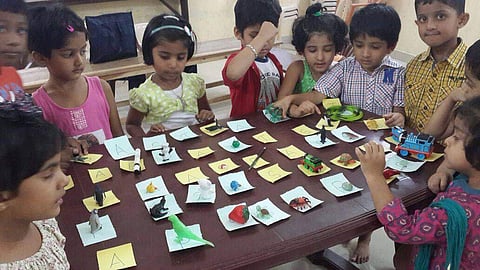

English or, as a matter of fact, any other regional language must be taught as another language of learning rather than another subject at schools, believes Latha Srinivasan, Founder of Chippersage. Started in 2009 by this former IT employee, Chippersage is a social enterprise involved in creating learning tools and solutions to help children comprehend anything that they read in English. Latha, who is a voracious reader herself, says, "Before starting Chippersage, I started a library for children that had a collection of over 8,000 books. We tied up with several NGOs to host children and provided them with various learning programmes. While the library doesn't exist anymore, I ended up developing a software program in which I included these learning tools and programmes for English. In 2013, I heard about the IIM Bangalore's incubation centre, NSRCEL, and that is where we launched these programmes as a part of Chippersage."
The programmes at Chippersage are available for children who are as young as three years to tenth graders. Latha says, "We don't see English teaching as a short-term programme. We start teaching the basics of reading when they are three years old. In most urban private schools, a good percentage of children cannot read and comprehend. In order to do this, one must have good skills and that is something our children lack. Therefore, our programmes are designed in a way that children learn the basics and develop those skills of comprehension with whatever they read." Latha and her team have adopted some of the tools of the International Reading Association Standards to assess the reading readiness in children. "Before, we tie-up with the schools to implement our programmes, we assess the reading readiness and suggest programmes. For instance, a child studying in Class 2, must be able to read 90 words per minute and an average adult must be able to read 350 words per minute. We watch for all this before we tell them where they stand."
What makes Chippersage unique is they don't take the grammar route to teach English. "It doesn't make sense to teach them what a noun is unless the children know how to form a sentence. Therefore, we teach basic English words through phonetics so that children can learn the construction of these worlds easily. Flow of English (FoE) is one of their programmes, designed to involve audio, visual and tactile teaching methods for children. If the child is taught the word 'splash', then they are not only taught its meaning but also, tactile cards representing those letters are used to help them join the words according to the pronunciation. There are three stages in this programme including beginners, learners and writers. While the beginners learn the alphabet, syllables, words, sight phrases, stories, word replay and so on, children in the learners' stage study words, sentences, passages, grammar and functional English for Math, Science and other subjects. Similarly, children in the writers' stage learn vocabulary, real-world scenarios, creative writing and so on," explains Latha who developed these programmes through her own experiences and with the help of English teachers.
We know that it is essential for children to learn English but it is equally important for teachers to learn the language too. "A Math teacher must be able to communicate with children in English and not ignore it assuming that it is the responsibility of an English teacher. Hence, we have two different programmes available for teachers who otherwise feel shy to communicate in English. One of them is called Teachers' English Fluency Development and the duration is for three months. Teachers can either take one-on-one teaching classes or they can attend these classes at school. There are three levels and each level has at least 60 lessons. While we certify teachers at each level, we check for what they have learnt. Currently, we are providing this programme online and over 3,000 teachers across India have taken it up. Now, they are confident enough to communicate with children in English," concludes Latha who is happy that their programme is opening doors for both children and teachers at many levels.
